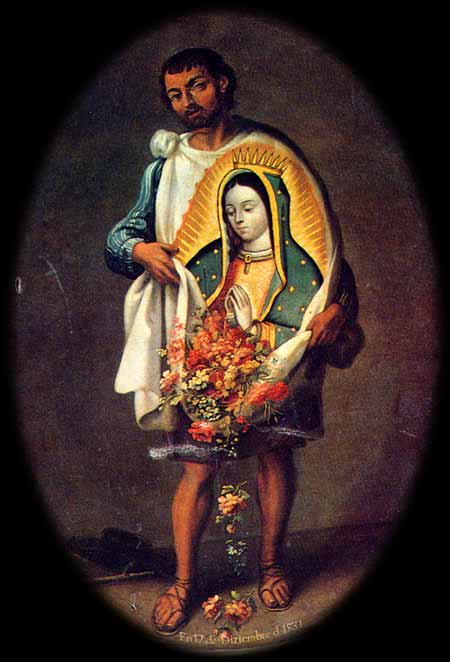 Content Challenge 182: In lines 126, 127, 134, 153, 154, and 157 we were told that Juan Diego found and collected many kinds of (exquisite) flowers —nepäpan (tlazoh-) xöchitl.
Content Challenge 182: In lines 126, 127, 134, 153, 154, and 157 we were told that Juan Diego found and collected many kinds of (exquisite) flowers —nepäpan (tlazoh-) xöchitl. But in lines 175, 176, and 181, they are specifically Castilian roses —caxtillan xöchitl— and in line 182 they are specifically many different kinds of Castilian roses —nepäpan caxtillan xöchitl.
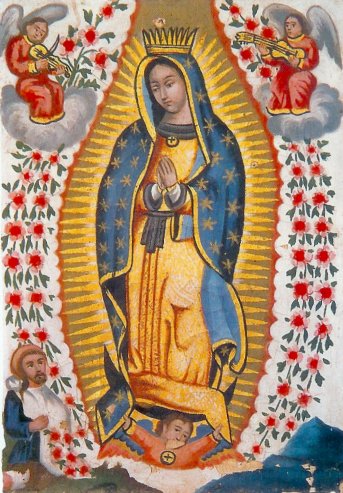
Thus even in the text the flowers have evolved from many kinds of flowers to many kinds of Castilian roses. Some artists, like the one at left, show many different kinds of flowers, others various colors of roses, and some artists, like the one on the right, limit themselves to red roses only.
Is this inconsistency simply an error in Valeriano's account? Or is it somehow part of the story (perhaps the trace of a tradition that is not otherwise represented in this text)? What is the best way for an artist to deal with the problem?
(Thanks to Karandeep Singh, class of 2021, Eleanor Roosevelt College, UCSD, for pointing out this problem.)

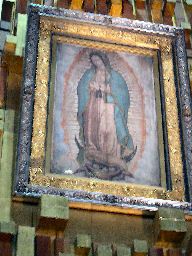 Content Challenge 184: The narrator interrupts his flow of events just at this climactic moment by referring to the fact that the tilma is still extent and is in "her sacred little house at Tepeyac, which is called Guadalupe." What narrative purpose, if any, is served by that interruption? Explain.
Content Challenge 184: The narrator interrupts his flow of events just at this climactic moment by referring to the fact that the tilma is still extent and is in "her sacred little house at Tepeyac, which is called Guadalupe." What narrative purpose, if any, is served by that interruption? Explain.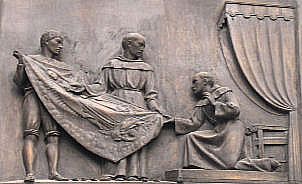
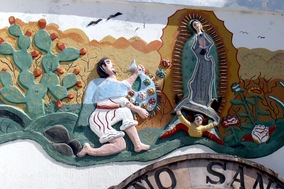
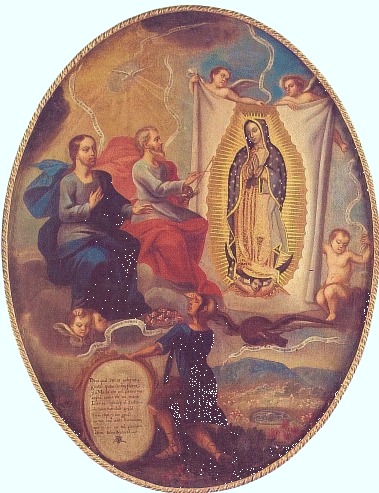 Despite skeptics, both in the past and today, the painting on the tilma is widely considered to be of miraculous origin. In this XVIIIth-century representation by Joaquín Villegas, now hanging in the Museo Nacional de Arte, we see great literalism as God the Father (accompanied by Jesus at the left and the holy spirit as a dove hovering overhead) wields a paintbrush while putti hold up the tilma to facilitate his work.
Despite skeptics, both in the past and today, the painting on the tilma is widely considered to be of miraculous origin. In this XVIIIth-century representation by Joaquín Villegas, now hanging in the Museo Nacional de Arte, we see great literalism as God the Father (accompanied by Jesus at the left and the holy spirit as a dove hovering overhead) wields a paintbrush while putti hold up the tilma to facilitate his work.